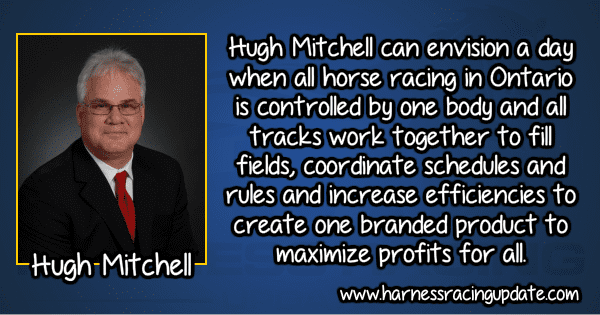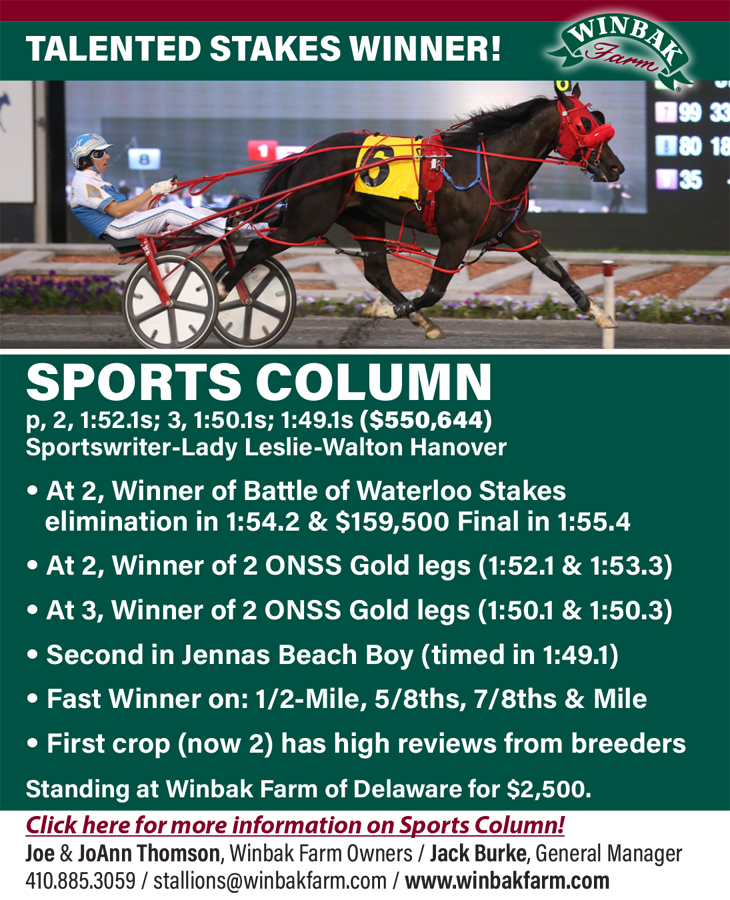
Overhaul in Ontario aims to create one group controlling all racing in the province
Ontario Racing chair Hugh Mitchell wants to create a more inclusive, transparent group that oversees all 15 tracks, all three racing breeds and includes horsepeople, breeders and horse retirement groups.
by Dave Briggs
Hugh Mitchell can envision a day when all horse racing in Ontario is controlled by one body and all tracks work together to fill fields, coordinate schedules and rules and increase efficiencies to create one branded product to maximize profits for all.
“That’s the dream, the vision, and I think it’s real and achievable,” said Mitchell, the chair of Ontario Racing (OR), an industry association that represents much, but not all, of the province’s horse racing industry.
Mitchell would like that to change.
On Dec. 14, OR announced it was undergoing a transformation to attempt to bring all horse racing parties in Ontario into the fold of an independent, not-for-profit industry organization — including horsepeople and horse retirement groups.
Mitchell said an all-encompassing organization would mean, “tracks aren’t competing with each other for horses or customers. We’re coordinating our efforts and driving down our costs of administering and producing this product. We’re being more efficient and we’re being more effective because we are talking to one another in an informed way.”
The transformation aims to merge OR with the eight-track Standardbred Alliance to, in effect, expand the work of the Alliance to the entire horse racing industry in Ontario — all 15 tracks and all three breeds: standardbred, thoroughbred and quarter horse.
The newly merged organization is committed to having a three-year business plan in place by April 1, 2018. The plan will include guarantees of purse payments for all member tracks, staking programs and race schedules, as well as establishing and administering common racetrack rules and policies.
“One of the reasons (the Standardbred Alliance) works so well is because Woodbine is the administrator of the Alliance and because we’re all pretty well aligned on the objectives of the Alliance and supporting live racing. It’s working. We want to take that business model and expand it to the industry,” Mitchell said. “One of the shortcomings of the Standardbred Alliance is that it’s only standardbred racetracks and it’s not all racetracks. As well, it doesn’t include horsepeople or breeders. It’s a great first step, but I don’t see it as the final step.
“The thing about OR is that OR includes all breeds and it includes breeders, horsepeople and racetracks, but it has its own shortcomings. It doesn’t include all racetracks and it doesn’t include all horsepeople. And it doesn’t include some industry organizations that I think are important in the future of racing. Two, in particular, come to mind: Long Run and the Ontario Standardbred Adoption Society. I think the racing industry has a real obligation to ensure that the equine athletes have a respectful home and are treated with dignity once they leave the racetrack… I think we can do a better job as an industry on finding homes for retired racehorses of all breeds.”
Beyond inclusiveness, the goal of an enhanced Ontario Racing — or whatever it may be called if it undergoes a name change — is transparency.
“You’re going to have a situation where horsepeople and tracks are talking about purse structure. Right now, the Standardbred Alliance has a discussion about purse structure, but in all fairness to horsepeople they are not in the room when the discussion is going on. That’s really not by design, it’s just evolved and so I’m of the view that we should take it to another level with respect to accountability and transparency amongst ourselves,” Mitchell said, adding membership will be voluntary, but, “I think that all will be welcomed and those that elect not to participate, so be it. That’s their prerogative, but I hope a good many of the racetracks and the industry organizations are able to support it and participate in it.”
Mitchell said a better, more inclusive, more transparent Ontario Racing should also help the industry secure long-term funding with the government through the Ontario Lottery and Gaming Corporation (OLG).
“Honestly, we really need to develop a new OR that can receive the funding and then be accountable and responsible to government to make sure it’s good value for the money spent in supporting racing. They tie together very nicely and it’s very important that they do tie together,” he said.
In the latter half of 2016, it was announced government funding was being proposed that would amount to some $94 million annually to cover a term as long as 23 years (through 2038). Yet, that funding has not, yet, materialized despite Mitchell’s hope that it would be in place before the end of 2017. With a provincial election looming in June of 2018 and the ruling Liberal Party low in the polls, there has been some concern in the industry that funding may not come through before the election. But Mitchell said the long-promised long-term funding is moving closer to reality.
“I would say that it’s moving forward very quickly. There’s some momentum. I’m hesitant to put a timeline on it, but I would say that it’s very near. It’s very near because the three key pillars in all of the funding discussions – (Ministry of) Finance, OLG and Woodbine – are more aligned today than they ever have been. So I’m really optimistic. It’s going to happen, I’m pretty sure of that, I would bet a lot that it will. Exactly when I can’t say, but I’ve got to give credit to the Minister of Finance and his staff, who have been very supportive and have worked really hard to try to find solutions,” Mitchell said.
Even with long-term funding, Mitchell said $94 million a year is going to be stretched pretty thin divided up between the province’s 15 racetracks.
“Not this year, but at some point in time, there will have to be tough decisions about how we divvy up a set number of dollars,” Mitchell said. “I think we can get through it if we focus on what’s right for the industry. If that’s the objective, to the betterment of horse racing – all breeds – we’ll find the solutions… but we need the mechanism to be able to arrive at those solutions and the mechanism is a new OR.”
In the past, groups that failed to gain a seat at the table of Ontario Racing or its predecessor, the Ontario Horse Racing Industry Association (OHRIA), were critical of the one-industry group concept controlled by the most powerful players. Mitchell said those skeptical about the attempt to create a more inclusive, transparent group need to leave those grievances in the past.
“We sail together or we sink apart. It’s that simple. Those are words, but we have to start acting that way. If you’re not prepared to act that way and be sincere and committed to one cause to the betterment of the industry, then, frankly, my view is that you’re not welcome… Everyone has to be prepared to be a part of something bigger and to come with an open mind and be willing to compromise, share and work together,” Mitchell said. “I say to them, ‘Get involved’, but come with the right attitude, because if you’re coming to be disruptive and distracting and divisive, my view is that you’re not welcome if that’s your attitude. But if you’re coming to help and support and work together, then ‘Welcome.’”
Similarly, some — particularly those connected to Fort Erie and Ajax Downs — have been critical of giving their long-term adversary, the Woodbine Entertainment Group (WEG), the power to coordinate racing for all. But Mitchell stressed both the OR and Standardbred Alliance boards were unanimous in the decision that WEG be in charge of coordinating the racing product for the province.
“I have experienced and I have witnessed Woodbine’s leadership and willingness to work with others for the greater good of the industry… so I’m a big supporter of them administering the industry, as others are, because their commitment to racing is real. They have the expertise, they have the infrastructure, they have the resources and I think it’s appropriate that they play a leadership role in driving the future of this industry.”
Mitchell added that WEG would be accountable to the OR board.
He said the governance structure of the new group is yet to be finalized, but the challenge is to create a manageable number of board members.
“It doesn’t make sense to me to have a board of 28 members,” Mitchell said. “I see a more robust committee structure.”
A key goal of the new body would be to create a strategic planning committee, he said.
“That’s something that our industry doesn’t do enough of. That’s not to be critical, but now is the time to strategically plan the next 3 to 5 years or longer out for ourselves, before somebody else does,” Mitchell said.
He acknowledged himself and others have made mistakes in the post-Slots at Racetracks Program (SARP) era, which is exactly the reason he wants to get it right now.
“We’re not perfect. And the structure we have today is not the best structure, so we’re recognizing that and saying, ‘Okay, let’s find another structure that takes us to another level that is appropriate for the times we live in and let’s run with it,’” Mitchell said.
In the end, he challenged the industry to come together before it was too late.
“This is clichéd, but we’re long past fighting, surely to God,” Mitchell said. “We’ve got to start working together. We’ve got to start making compromises amongst ourselves for the greater good of the industry. And this will be a test to see if the industry can do this. I think they can, with the right leadership.”













